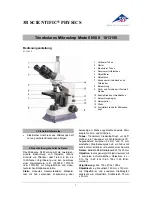
5
STEINDORFF
®
adjustable aperture iris diaphragm incorporated into the condenser, which is important in
securing correct illumination, contrast, and depth of field; a graduated scale indicates the
approximate adjustment (size) of the aperture diaphragm.
Trinocular phototube (50% vis, 50% doc) with 10MP digital eyepiece camera and 8'' LCD
camera available to capture images and view live video of the specimen on a computer or
screen.
3.
ASSEMBLY
Before assembly, make sure to remove the transportation security screws: two screws under the specimen
stage, and one screw on the bottom of the stand to protect the focusing parts (please see picture above)
1.
Mount the binocular or trinocular head onto the body of the microscope and tighten the head
clamping screw.
2.
Screw up the objectives in the order of powers.
3.
Insert eyepieces into the tubes.
4.
Mount the condenser
a.
Turn the coarse focus knobs to raise the specimen stage to the top of its range.
b.
Turn the condenser focus knob to bring the condenser down to its lowest position.
c.
Loosen the condenser clamping screw, put the condenser to the holder, and tighten the
condenser clamping screw.
d.
Turn the condenser focus screw to raise the condenser to a working position.
5.
Insert the illuminator source module onto the stand base.
6.
If a trinocular head is mounted at step 1, install a CCD adaptor
































